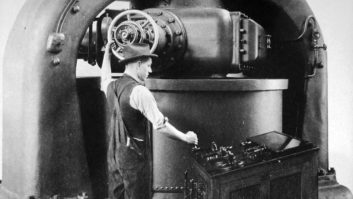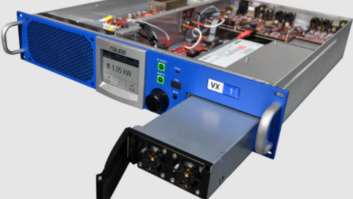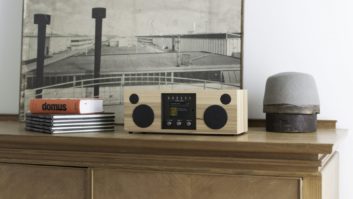
Fig. 1: Add this relay to prevent shorted transistors in the MW-1.
Usually after a transmitter is discontinued, any hope of upgrades or improvements fades. Some enterprising engineers can’t help but fix a problem.
Ted Fuller of Fuller Electronics of Salisbury, N.C., offers a tip for owners of the old Harris MW-1 transmitter. In addition to providing full-service repair and recalibration of broadcast equipment, Ted does his fair share of contract work.
At one of his contract sites he was losing a lot of MW-1 output transistors. Ted writes that by accident he discovered that the Q2 transistors in the A1 through A12 RF/AF output modules were being damaged at the moment that the transmitter was turned off.
Ted also noticed that the PA voltage meter would shoot up briefly for a second after transmitter turn-off. On this particular transmitter, the +140 volt supply discharge resistor, R11, was a 10 ohm, 200 watt resistor. Ted noted that some of the MW-1 schematics recommended changing R11 to 100 ohms at 200 watts.
When he tried this, it caused the meter PA voltage meter to shoot up higher, and for longer. Ted decided to change it back to 10 ohms until he found the problem. After probing around the transmitter with an oscilloscope, Ted made an interesting discovery. The source of the problem is the A17 Audio Driver Board.
When the transmitter turns off, on/off relay K3 immediately turns off power to the A17 Q1 collector. This turns off A17 Q2, which causes A17 Q3 to go into full conductance, discharging whatever is left in the 160 volt supply straight into the bases of the A1 through A13 Q2 transistors on all A1through A12 RF/AF output modules.
Ted’s solution was to install and connect a relay to the junction of the A17 Q2 collector and R12 on the Audio Driver Board. The relay would short this junction to ground immediately upon transmitter turn-off. Using the normally closed contacts of the added relay will maintain a short circuit from the A17 Q2 collector to ground when the transmitter is off.
At the moment of transmitter turn-off, this shorting of A17 Q2 shuts down A17 Q3 and helps to discharge the +160 volt supply through A17 R12. This prevents A17 Q3 from discharging the +160 volt supply into the A1through A12 Q2 transistors.
The coil in the added relay is paralleled with the coil of K4, through a 120 ohm 2 watt resistor as shown in Fig. 1. The typical control voltage is +30 volts, and the relay that he used was a 24 VDC octal-base relay. The job of K4 is to activate the main +140 volt supply contactor K2, and discharge the +140 volt supply through R11 when the transmitter is turned off. Ted placed the added relay on the back side of the front door, and ran a wire from it to A17 R12. Ted also decided to leave R11 at 10 ohms for faster discharge. Make sure you place a diode in the correct polarity across the coil of the added relay.
After making the modification, you should see the PA voltage meter go down and stay down at transmitter turn-off. If for some reason the added relay stays closed, the transmitter will simply not produce a carrier, and will not harm the circuitry. A17 R12 would dissipate around 5 watts, and is rated for 12 watts.
Since his modification, no transistors have been lost.
* * *
On the topic of older transmitters, several companies have stepped up to the plate to offer spare parts for models that are no longer serviced by their original manufacturers.
For the RCA product line, visit rcatransmitters.com/. Stuart Cook has been involved with RCA transmitters since the mid-1970s. He also provides technical assistance.
Paul Gregg still provides support for Elcom Bauer transmitters, with a full line of spares. Bookmark www.bauertx.com.
For CCA, CSI and McMartin transmitter parts, contact Charlie Goodrich in Omaha. Goodrich Enterprises can be found at www.goodrichenterprises.com.
Know of another good source? E-mail me at [email protected].
John Bisset marked his 40th year in broadcasting recently. He is international sales manager for Europe and Southern Africa for Nautel and a past recipient of the SBE’s Educator of the Year Award. Reach him at[email protected]. Faxed submissions can be sent to (603) 472-4944.
Submissions for this column are encouraged and qualify for SBE recertification credit.












